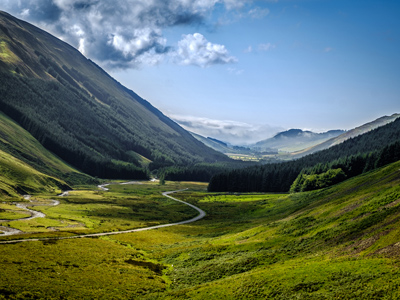
Ask the AI Tutor
Need help with Glacial Erosion Landforms? Ask our AI Tutor!
AI Tutor - Lucy
Connecting with Tutor...
Please wait while we establish connection

Test your geography skills in this quiz.
Glacial Erosion Landforms
Ice can carve mountains into dramatic shapes. This quiz looks at how glaciers erode rock to create corries, arêtes, pyramidal peaks and U-shaped valleys.
1 .
What gives a glacier its erosional power?
Loose blocks of ice
Pieces of rock embedded within the ice
Lateral moraines
Wind and rain moving the ice from side to side
The weight of the glacier means that any pieces of rock that are embedded in the ice can scratch and scrape the soil and bedrock, causing the erosion
2 .
What is a truncated spur?
A feature of a valley created by a river bursting its banks due to a glacier melting rapidly
A feature of a ribbon lake
An interlocking spur that has been cut by a glacier
Another name for an interlocking spur
Interlocking spurs are features of a young river valley. As a glacier moves down the valley, the tips of the interlocking spurs are truncated (cut off and made shorter) by the glacier
3 .
Which of the following features is caused by freeze-thaw weathering?
A valley
A pyramidal peak
A ribbon lake
All of the above
Frost shattering of rocks at the summit of a mountain poking up from an ice sheet, combined with the presence of several glaciers around it, creates a pyramidal peak
4 .
The place where a glacier forms is ...
corrie
cwm
cirque
all of the above
They all describe the same feature
5 .
Which of the following features is created by the overdeepening of a glacial valley by the glacier that made it?
Ribbon lake
String lake
Oxbow lake
Glacier lake
These are long narrow lakes found in U-shaped valleys
6 .
How is a hanging valley formed?
Plate tectonics pushes it upwards
Water rushing out from a glacier as it is melting in the summer
Freeze-thaw weathering occurs along a fault line that joins an established glaciated valley
A small glacier flows into a larger one
There needs to be a significant difference in size between the two glaciers
7 .
Crib Goch is an arête on Snowdon (a mountain in Wales). It lies between two U-shaped valleys. Which of the following is the most likely way it was formed?
Wind erosion
Volcanic activity
Freeze-thaw weathering
An earthquake that happened just after Snowdon was formed
Arêtes are usually narrow areas of rock between glaciated valleys
8 .
What is the letter that describes the profile of a valley that has been cut by a glacier?
U
V
W
X
A glaciated valley has a very different profile to a valley cut by a river
9 .
Which of the following is not a glacial erosion landform?
Hanging valley
U-shaped valley
Drumlin
Cwm
Drumlins are depositional features created by glaciers
10 .
What causes a glacier to move?
Gravity
Molten ice
Molten lava
Storms pushing down on the ice
Glaciers move naturally downhill owing to the Earth's gravity
**Unlimited Quizzes Await You! 🚀**
Hey there, quiz champ! 🌟 You've already tackled today's free questions.
Ready for more?
Ready for more?
🔓 Unlock UNLIMITED Quizzes and challenge yourself every day. But that's
not all...
not all...
🔥 As a Subscriber you can join our thrilling "Daily Streak" against other
quizzers. Try to win a coveted spot on our Hall of Fame Page.
quizzers. Try to win a coveted spot on our Hall of Fame Page.
Don't miss out! Join us now and keep the fun rolling. 🎉
**Unlimited Quizzes Await You! 🚀**
Hey there, quiz champ! 🌟 You've already tackled today's free questions. Ready for more?
🔓 Unlock UNLIMITED Quizzes and challenge yourself every day. But that's not all...
🔥 As a Subscriber you can join our thrilling "Daily Streak" against other quizzers. Try to win a coveted spot on our Hall of Fame Page.
Don't miss out! Join us now and keep the fun rolling. 🎉






